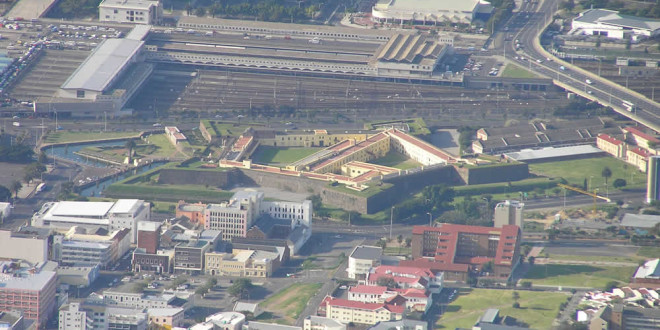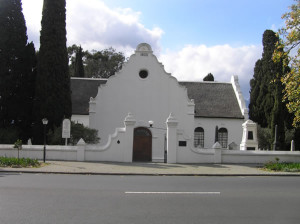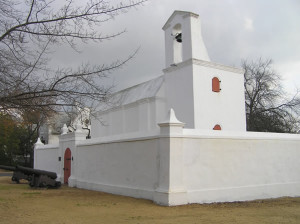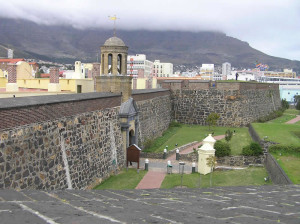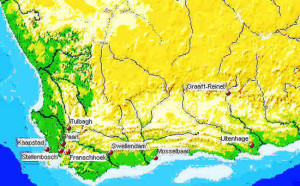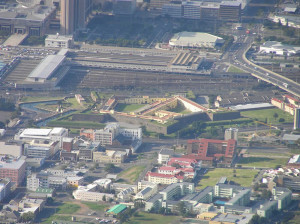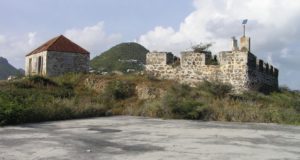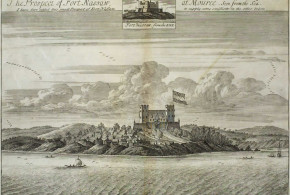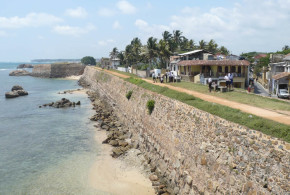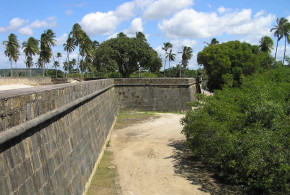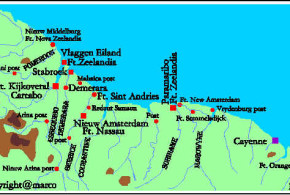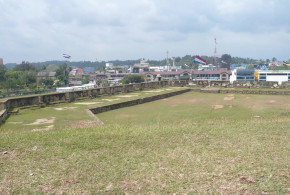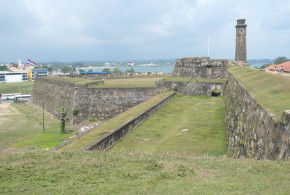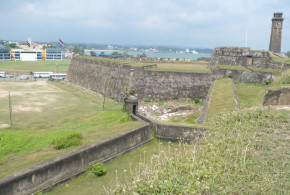Written by Marco Ramerini. English text revision by Dietrich Köster.
The Dutch settlement history in South Africa began in March 1647 with the shipwreck of the Dutch ship Nieuwe Haarlem. The shipwreck victims built a small fort named “Sand Fort of the Cape of Good Hope”. They stayed for nearly one year at the Cape. Finally they were rescued by a fleet of 12 ships under the command of W.G. de Jong. On one of these ships was Jan van Riebeeck, too.
After their return to Holland a part of the shipwrecked tried to persuade the Dutch East India Company to open a trading center at the Cape. In 1652 a Dutch expedition of 90 Calvinist settlers under the command of Jan Van Riebeeck founded the first permanent settlement near the Cape of Good Hope. They arrived in the bay of today’s Cape Town – later named Table Bay/Tafelbaai – on 6 April 1652 on board of five ships: the “Reijger”, the “Oliphant”, the “Goede Hoop”, the “Walvisch” and the “Drommedaris”.
A square wooden fort with four bastions was quickly built on the left bank of the Salt River, where is now the Central Post Office, and later were built also two redoubts near the shore. They were named “Kyckuit” and “Duinhoop”. In 1666 the first stone was laid on 2 January and the original fort was replaced by a new stone fort named Castle of Good Hope/Kasteel de Goede Hoop, a massive pentagonal fortress with a moat and bastions at each corner. The bastions were named: “Nassau”, “Leerdam”, “Oranje”, “Catzenellenbogen” and “Buuren”.
As Prof. Ch. R. Boxer wrote in his book “The Dutch seaborne Empire”, “the Cape developed into a colony, which was something unique, save for the short-lived New Netherland, in the possesion of the Dutch East and West India Companies. It had a healthy, subtropical and partly fertile hinterland, which was virtually unoccupied. White colonisation was as feasible here as it had been in New Netherland, with the additional advantage that there was no rival European nation close at hand.”
On 3 June 1652 the first child was born. The development of a community of free-burghers was the main secret of the success of the settlement. From the beginning the first trades with the Hottentots were started being residents of the zone, but the relationship with these tribes were often problematic. In 1655 the first coast vessel made of Cape timber was lauched. In 1657 two groups of farmers settled about three miles from the castle at Groenevelt (or Dutch Garden) and Rondebosch. In 1658 the population of the whole Cape Colony consisted of 162 persons, slaves included. In 1659 wine was pressed from Cape grapes for the first time.
During the first years the natives were the most persistent problem of the colony. They frequently stole cattle. To solve the problem it was decided to build a strong fence around the farms to protect the cattle. These defences were extended from Blaauwberg across the bay to Salt River and then through Groote Schuur to the hill of Wynberg. Three watch-houses were also built. The whole settlement was thus protected from Hottentot incursion. Saldanha Bay, Dassen Island and Robben Island were developed as outposts of trade and stock raising. In 1660 a Dutch ship with 150 slaves from Angola arrived at the Cape. Later the same year another ship arrived with more slaves. Thus the number of slaves in the settlement rose to 187. A school was opened to teach Dutch and religion to the children of the white settlers and to the Mulattos and Hottentots, too.
When Jan van Riebeeck laid down his office in May 1662, there were 39 free farmers, of whom 15 were married. Free labourers employed on the farms amounted to 54. The whole farming community was of some 130 persons, besides the servants and the officials of the VOC. After the departure of Jan van Riebeeck a period of confusion began in the colony: During the first ten years 4 governors were appointed and after this started the war with France.
On 2 Janaury 1666 during the government of Wagenaer was laid the foundation stone of the Castle of Good Hope, which was completed in 1674 during the government of Isbrand Goske. In 1672 the white population was less than 600 souls, of whom only 64 were male free-burghers. On 9 April 1678 was laid the first stone of the Dutch Reformed Church of Cape Town. This building was completed 25 years later.
In 1679 the colony had 289 Europeans of whom 142 were free-burghers and 191 slaves. As in Ceylon the free-burghers in Kaapstad (Cape Town) were in most cases tavern-keepers or to a lesser extent craftsmen and shopkeepers. In this year a new governor was appointed. He was the Mauritius-born Simon van der Stel. In the first year of his government he founded Stellenbosch, the second oldest town in South Africa, and during the twenty years of his government he promoted the immigration of new families from The Netherlands, built a new hospital and thoroughly developed the colony.
In 1688 a group of about 200 French Huguenots arrived. They settled in Stellenbosch, Drakenstein, Paarl and Franschhoek, developing farming and in particular vineyards. In 1691 the population of Kaapstad or “De Kaap” consisted of 1000 Europeans and 400 Slaves. In 1695 there were still only 340 free-burghers in the colony.
In February 1699 Simon van der Stel handed over the government to his son Willem Adriaan van der Stel. During his administration he had several problems with the French Huguenot settlers. During the administration of Maurice de Chavonnes (1714-1724) a series of small outposts were built at strategic points in Tulbagh, Klapmuts, Groenekloof and Saldanha Baai to prevent Hottentot raids.
In 1717 there were more than 5,000 souls, of whom 2,500 were Europeans in the colony (in most cases farmers and breeders) and 2,500 slaves.
The growth of the population in Dutch South Africa |
||||||
| Year | Whites Free Burghers + Servants | Slaves | Total Whites +Slaves | Free Burghers | Soldiers | Total Whites +Slaves +Soldiers |
| 1652 | 90 | 0 | 90 | |||
| 1658 | 82 | 80 | 162 | |||
| 1660 | 187 | |||||
| 1672 | 221 | 200 | 421 | 64 | ||
| 1679 | 289 | 191 | 480 | 142 | ||
| 1685 | 200 | |||||
| 1691 | 1.000 | 400 | 1.400 | |||
| 1695 | 340 | |||||
| 1699 | 1.232 | 536 | 1.768 | 414 | 751 | 2.519 |
| 1717 | 2.500 | 2.500 | 5.000 | 2.000 | ||
| 1733 | 2.598 | 2.218 | 4.816 | |||
| 1756 | 5.000 | |||||
| 1780 | 12.000 | |||||
| 1795 | 16.000 | 16.839 | 32.839 | |||
In 1720 the Breede and Oliphant’s valleys were populated. Jan de la Fontaine became governor in 1724 and he was in control of the Cape Colony until 1739, except for an interval of three years, when Gysbert Noodt was governor. La Fontaine was a quietly efficient governor. In 1730 the Little Karoo valley was reached and in 1734 he started to colonize the Mossel Baai area.
The first governor born in the Cape was appointed in 1739. He was Henry Swellengrebel. His name has been preserved in the town of Swellendam, which was founded during his government. During the government of Ryk Tulbagh (1751-1771) the Orange River was reached. In these years the French astronomer Abbé de la Caille made a chart and a catalogue of the sky of the Southern Hemisphere in Kaapstad. During the Tulbagh successor, Joachim van Plettenberg (1771-1785), the exploration of the Orange River valley was completed. Van Plettenberg was a capable and energetic governor.
In 1780 there were 11,000-12,000 free-burghers, of whom at least 3,000 lived in Kaapstad. The Boers in the late 18th century regarded South Africa as their fatherland. In 1785 a new governor was appointed: He was van de Graaff. During his administration the town of Graaff-Reinet was founded. Kaapstad was now a town of 4,300 settlers without counting blacks and sailors. Stellenbosch was the foremost farming settlement.
In 1794 the Dutch East India Company went bankrupt and in 1795 the British seized the colony. The Dutch surrender in 1795 is known as the Capitulation of Rustenburg. In 1795 the town of Kaapstad had 14,021 inhabitants, of whom 4,357 were Europeans. In 1795 the slaves in the whole colony amounted to 16,839 and the Whites totalled nearly 16,000.
At the 1802 Treaty of Amiens the Netherlands (now Batavian Republic) recovered the colony. Jacob de Mist was appointed as new Dutch governor. After three years of government he handed the command over to John Williams Janssens. On 18 Janaury 1806 he surrendered the colony to the British at Blaauwberg.
|
CAPE GOVERNORS |
YEARS |
| Jan van Riebeeck | 1652-1662 |
| Zacharias Wagenaer | 1662-1666 |
| Cornelis van Quaelberg | 1666-1668 |
| Jacob Borghost | 1668 -1670 |
| Peter Hackius | 1670-1671 |
| Albert van Breughel act. | 1671-1672 |
| Isbrand Goske | 1672-1676 |
| Johann Bax van Herentals | 1676-1679 |
| Simon van der Stel | 1679-1699 |
| William Adrian van der Stel | 1699-1708 |
| Louis van Assenberg | 1708-1713 |
| Maurice de Chavonnes | 1714-1724 |
| Jan de la Fontaine act. | 1724-1726 |
| Gysbert Noodt | 1726-1729 |
| Jan de la Fontaine |
1729-1739 |
| Adrian van Kervel |
1739 for3 weeks |
| Henry Swellengrebel | 1739-1751 |
| Ryk Tulbagh | 1751-1771 |
| Joachim van Plettemberg | 1771-1785 |
| van de Graaff | 1785-1791 |
| John Reinus act. | 1791-1793 |
| Abraham Sluysken | 1793-1795 |
| English occupation | 1795-1802 |
| Jacob de Mist act. | 1802-1805 |
| John Williams Janssens | 1805-1806 |
- Stellenbosch, South Africa. Author and Copyright Marco Ramerini.
- Castle of Good Hope (Kasteel de Goede Hoop), Cape Town, South Africa. Author and Copyright Marco Ramerini
- Paarl, South Africa. Author and Copyright Marco Ramerini
- Castle of Good Hope (Kasteel de Goede Hoop), Cape Town, South Africa. Author and Copyright Marco Ramerini
BIBLIOGRAPHY:
– Guelke, Leonard “Freehold farmers and frontier settlers, 1675-1780” In: “An Expanding World” Vol. n° 4; Disney, A. “Historiorgraphy of Europeans in Africa and Asia 1450-1800” Ashgate Variorum, vol. n° 4, 1995; pp. 174-216 Also in: “The shaping of South African Society 1652-1840” 1986, Middelton, Connecticut, USA, pp. 66-108
– Guelke, Leonard “The anatomy of a colonial settler population: Cape Colony, 1657-1750” In: “An Expanding World” Vol. n° 29; Nizza da Silva, M. B. “Historiorgraphy of Europeans in Africa and Asia 1500-1800” Ashgate Variorum, vol. n° 29, 1998; pp. 293-313 Also in: “International Journal of African Historical Studies” Vol. 21, n° 3 1988, Boston, MA, USA, pp. 453-473
– Raven-Hart, R. “Cape of Good Hope 1652-1702. The first fifty years of Dutch colonisation as seen by callers” 2 vols Vol. I: xvi+222 pp. with 28 b/w illust. Vol. II: xii+303 pp. with 37 b/w illust. A. A. Balkema, 1971, Cape Town, South Africa. 103 accounts by visitors to the Cape between 1652 and 1702, taken from the original Dutch, English, French, Portuguese, Danish and German. The Foundations 1652-1662. Too many Cooks 1663-1679. Expansion and Exploration 1680-1698. Greed and Graft 1699-1702.
– Sleigh, D. “The Forts of the Liesbeeck Frontier” Castle Military Museum, Cape Town, South Africa. [The South African Military History Society]
– Theal, G. “The history of South Africa under the administration of the Dutch East India Company (1652 – 1795)” 459+462 pp. maps, 2 voll. Swan Sonnenschein & Co., 1897, London, United Kingdom.
 Colonial Voyage The website dedicated to the Colonial History
Colonial Voyage The website dedicated to the Colonial History
